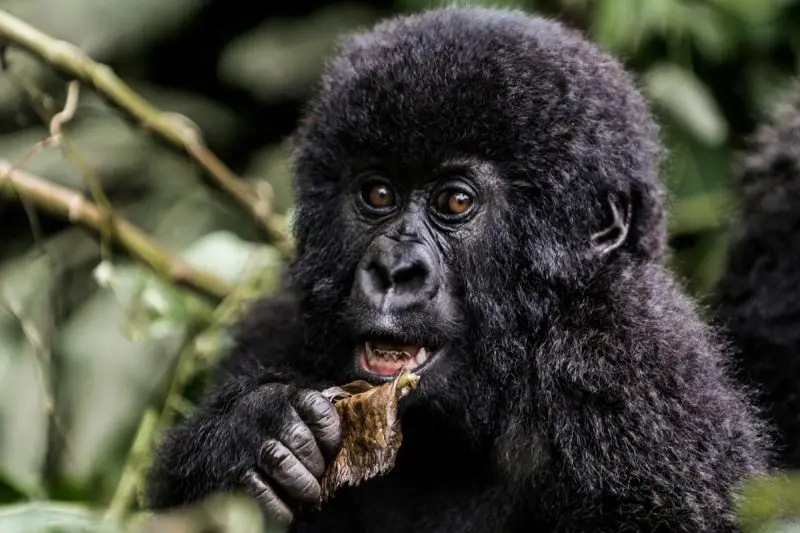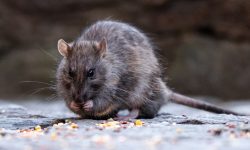Gorillas are incredibly strong, intelligent, and gentle herbivores whose diet plays a major role in shaping their behavior, growth, and overall health. In the wild, these great apes spend hours each day foraging across dense forests, gathering nutrient-rich plants that fuel their powerful bodies. Their feeding habits change based on season, habitat, and food availability, allowing them to thrive in both lowland jungles and high-altitude mountain regions.
Understanding what gorillas eat not only highlights their place in the ecosystem but also reveals how essential forest conservation is for their survival. Their plant-based diets support digestion, maintain hydration, and help regulate natural plant growth across the forest floor. The foods they choose are packed with fiber, minerals, and slow-release energy that match their slow, peaceful lifestyle.
Before exploring the 20 natural foods gorillas love the most, it’s important to understand how their digestive system works and why their diet is so different from other primates.
Understanding the Gorilla Diet

Gorillas are primarily folivores, meaning their diet is dominated by leaves, shoots, and stems. These foods are rich in fiber but low in calories, which is why gorillas must eat large quantities each day. Adult males may consume up to 40 pounds of vegetation daily, spending almost the entire morning and afternoon feeding.
Their multi-chambered stomachs break down fibrous plant material through fermentation, releasing nutrients that help maintain muscle mass. Despite their massive size, gorillas rarely eat meat. Their strength comes almost entirely from plants, showing just how efficient their digestive systems are.
Hydration also comes directly from vegetation, meaning gorillas drink water only occasionally. Moist leaves, fruits, and shoots provide nearly all the fluids they need.
Now let’s dive into the 20 foods gorillas love most in the wild, written in the short-paragraph format you prefer.
20 Natural Foods Gorillas Love the Most
1. Leaves
Leaves are the foundation of a gorilla’s diet. They browse from dozens of tree and shrub species, choosing fresh, soft leaves that are easy to chew and high in moisture. Leaves provide steady fiber and minerals that support digestion.
Highland gorillas rely heavily on leaves because fruits are scarce in mountain habitats. Their large jaws and tough molars make it easy to grind dense foliage for long periods. Leaves also help maintain hydration during dry seasons.
Because they grow year-round, leaves give gorillas a consistent food source even when other plants disappear.
2. Shoots
Young shoots are tender, nutrient-rich, and full of moisture, making them a treasured food source. Gorillas often pull entire shoots from the ground and strip them with their teeth.
These soft plant parts offer vitamins and minerals that boost energy during long travel days. Shoots are especially important in the wet season when new growth appears everywhere.
The ease of chewing young sprouts makes them a favorite of both adults and juveniles.
3. Stems
Stems provide essential roughage that keeps a gorilla’s digestive system functioning properly. They chew through thick stems with powerful jaws, extracting sap and nutrients.
Many stems contain natural electrolytes that support hydration. In forest understories, gorillas break stems open and eat the soft inner fibers.
Stems become especially important in dry seasons when leaves and fruits are less abundant.
4. Fruits
When fruits are available, they become a highly preferred food. Gorillas enjoy figs, berries, guavas, and wild plums, all rich in natural sugars and antioxidants.
Fruit supplies quick energy that supports travel and social activities. Mountain gorillas eat fewer fruits due to habitat limitations, but lowland gorillas can spend hours fruit-foraging.
Seasonal fruit bursts also strengthen family bonds, as groups share ripe finds during long feeding sessions.
5. Bark
Tree bark offers minerals and fibrous material that support digestion and dental health. Gorillas scrape bark using their teeth, often focusing on species with softer outer layers.
Bark consumption increases during the dry season when fresh leaves become scarce. The inner bark contains sap that helps maintain hydration.
This food is a reliable fallback that prevents nutritional gaps during harsh periods.
6. Roots
Roots provide dense energy and moisture, especially in lowland forests. Gorillas dig them up using their hands, exposing soft inner layers.
These underground plant parts contain carbohydrates and minerals that help build muscle mass. Roots are particularly useful when fruits are unavailable.
Their cool moisture helps gorillas stay hydrated on hot days.
7. Vines
Vines grow abundantly across African forests and offer tender leaves and water-rich stems. Gorillas pull them down from trees or break them apart with their hands.
Many vines contain natural sugars and vitamins that support energy levels. Their flexibility makes them easy for younger gorillas to chew.
Vines also grow quickly, providing fresh foliage after seasonal rains.
8. Bamboo Shoots
Bamboo shoots are a delicacy for mountain gorillas. They appear only during certain months, creating a short but abundant feeding season.
Shoot tips are soft, sweet, and packed with nutrients that support growth and weight gain. Entire gorilla families gather in bamboo forests to feed together.
Their high moisture content makes bamboo shoots an excellent hydration booster.
9. Wild Celery
Wild celery grows in wetlands and is rich in water, fiber, and natural salts. Gorillas pull entire stalks from the ground and eat them from base to leaf.
This plant supports electrolyte balance, especially during warm seasons. Its crisp texture makes it refreshing and easy to digest.
Lowland gorillas often return to the same patches repeatedly because of its reliability.
10. Flowers
Flower blossoms supply natural sugars and antioxidants. Gorillas pluck them gently from branches, savoring their sweet taste.
Flowers bloom seasonally, creating short periods of high nutritional value. Their bright colors attract gorillas exploring the forest canopy.
Though small, flowers contribute valuable nutrients to balance a leaf-heavy diet.
11. Seeds
Seeds provide fats and minerals that support body condition. Gorillas access seeds by breaking open fruits or stripping pods from vines.
These concentrated nutrients help gorillas maintain energy during long travel distances. Seeds also offer fiber that aids digestion.
They are most available during late wet seasons when plants reproduce.
12. Pith
Pith is the soft, spongy tissue inside stems and branches. Gorillas split stems using their teeth to reach the nutritious interior.
Pith is rich in moisture, making it important during dry periods. It contains minerals essential for joint and bone health.
This inner material is easy to chew, making it suitable even for young gorillas.
13. Thistles
Thistles may look intimidating, but gorillas handle them effortlessly thanks to their tough lips and tongues. They strip leaves from thorny plants without injury.
These plants offer vitamins, moisture, and fiber. Thistles stay green longer than other plants, extending their availability.
Their presence in highland habitats makes them essential for mountain gorillas.
14. Nettles
Stinging nettles are another surprising favorite. Gorillas fold them to neutralize the sting before eating.
Nettles contain protein and iron, supporting muscle growth and blood health. Their leaves are soft once damaged, making them easy to chew.
They grow quickly after rainfall, forming a dependable seasonal food.
15. Mushrooms
Wild mushrooms provide trace minerals, hydration, and natural probiotics. Gorillas eat them directly from the forest floor.
Fungal nutrients boost gut health and support strong immune function. Mushrooms also offer moisture during dry spells.
Though not a primary food source, they add valuable diversity to the gorilla diet.
16. Bulbs
Bulb plants in lowland forests supply dense nutrients and natural sugars. Gorillas dig them up with their hands or break soil with their feet.
Bulbs provide long-lasting energy ideal for cold or rainy periods. Their soft texture makes them easy to chew.
They are most common during early wet seasons.
17. Pods
Seed pods contain proteins, fats, and vitamins essential for maintaining body condition. Gorillas pull pods from branches or collect fallen ones.
Pods become especially important when fruit production slows. Some species produce sugary pulp that gorillas enjoy.
Their strong jaws easily crack tough pod shells.
18. Grasses
While not their favorite, grasses contribute fiber and hydration, particularly in open habitats. Gorillas graze on tender grass shoots during seasonal growth.
Grass helps regulate digestion and ensures steady gut movement. Its wide availability makes it a useful supplement.
Young gorillas often snack on grass while practicing feeding skills.
19. Fallen Fruit
Gorillas happily eat fallen fruit when fresh options are scarce. These fruits are softer and easier to digest due to natural fermentation.
Fallen fruit provides hydration and quick-release sugars that fuel long-distance walking. Lowland gorillas rely on this source heavily during fruiting cycles.
These fruits also attract insects, giving gorillas additional nutrients.
20. Mineral-Rich Soil
Although not traditional “food,” gorillas often consume soil to balance their internal chemistry. This behavior is called geophagy.
Soil neutralizes plant toxins found in certain leaves and helps absorb iron and calcium. It also replaces minerals removed during digestion.
High-mineral soil sites are revisited year after year by gorilla groups.
FAQs About What Gorillas Eat
How much do gorillas eat in a day?
An adult gorilla may consume 30–40 pounds of vegetation daily, depending on habitat and season.
Do gorillas drink water?
They rarely drink. Moist leaves, shoots, and fruits supply nearly all the hydration they need.
Do gorillas eat meat?
Only in extremely rare, accidental cases. Their diet is almost entirely plant-based.
Why do gorillas eat so much fiber?
Fiber supports their large digestive system and provides slow-release energy suitable for their lifestyle.
Do gorillas eat bananas?
Wild gorillas do not naturally encounter bananas, but they may eat wild banana species in certain forests.
What do baby gorillas eat?
Infants nurse for the first 3–4 years, gradually eating leaves, shoots, and fruits as they grow.
Do gorillas have favorite foods?
Yes — bamboo shoots, fruits, and soft leaves are among their top preferences.
Does diet differ between mountain and lowland gorillas?
Yes. Lowland gorillas eat more fruit, while mountain gorillas rely heavily on leaves and shoots.
How does gorilla diet help the ecosystem?
They disperse seeds, prune vegetation, and maintain forest growth balance.
Do gorillas ever overeat?
They pace themselves naturally, spending hours eating fibrous foods that prevent overeating.
Final Thoughts
Gorillas thrive on a plant-rich diet that keeps them strong, hydrated, and healthy throughout their lives. Their food choices reflect the rhythms of the forest, changing with seasons and habitat conditions. Understanding what gorillas eat reminds us how vital their ecosystems are and why protecting their natural environment ensures their survival for future generations.






